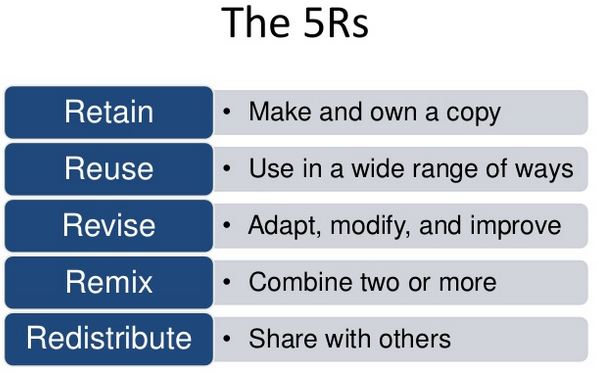
Among of the most lauded benefits of OER are the 5 R’s — reuse, revise, remix, redistribute, and retain.
The ability of educators and students to continually update, improve, and iterate on their learning materials is the basis for rich learning. This model stands in marked contrast to the traditional publishing, whereupon textbooks are updated every seven years or so, and updates are made by publisher worker bees without a lot of learner input. In fact, once published, users are not permitted to share any enhancements they make to the materials. OER, on the other hand, empowers teachers and students to become more reflective and self directed with their learning and to share their improvements with others, elevating the whole enterprise.
In a conversation on Twitter yesterday (see below), Bill Fitzgerald said “OER still suffers from an overemphasis on delivery and ancillaries, and insufficient attention to streamlining reuse.”
This brought to mind many things for me, among them some action research that has reported that many educational policymakers and decision makers see reuse, and particularly revision and remix, to be a negative.
This isn’t particularly surprising. Traditional education has a rigid command and control structure. Curriculum is developed by big brains in an ivory tower. It is approved by state legislators, departments of education, and district committees. It is then brought to teachers to deliver to students, with neither group having much input on the process.
Now, in fairness, this process varies a fair amount from state to state and district to district. But, by and large, and especially in the era of pacing and “fidelity to the textbook,” there isn’t a lot of teacher or student participation in a great deal of classroom curricula.
This is where I personally have to step back from my own views on open learning, which is diametrically opposed to this, and focus for now on open educational resources and how we can best position them to be adopted as core curriculum in a large number of classrooms. (This is the goal of the K-12 OER Collaborative, among others.)
If district decision makers don’t feel positively about their teachers remixing instructional materials, then it doesn’t make sense to me to position that as a benefit (or even mention it). Now some argue that it is our job to “educate” these decision makers about the benefits of the remixing, of how it can elevate the professionalism of their teachers and advance the learning of their students.
And while I love to evangelize these benefits, it is just too heavy (and unnecessary) of a lift if you’re trying to sell a district an open licensed core curriculum. There are so many other objections to be addressed, so many other hurdles to jump over, that it just isn’t worth it. In my opinion, it is also likely to be unsuccessful in most cases.
So let’s leave the 5 r’s for the choir and focus on showing how OER meets already-identified needs of K-12 districts.
[Note: A silver lining to all this is that many teachers do see remix as a benefit. In addition, the best teachers revise and remix even proprietary instructional materials every day (though they may not call it that). Add a resource here. Take out a section there. Make an assignment from a bit of this and a bit of that. Teachers will keep doing that no matter what decision makers favor, and OER gives them a better and easier way to do that. And students will benefit. They can even join in on the remix fun.]

“The 5 R’s” retain, reuse, revise, remix & redistribute #edtech #tlchat http://t.co/HpdWHvdd7b
Pingback:Does Ownership of Instructional Materials Matter? | Doug Levin | EdTech Strategies